Dec 12, 2018
Taking Flight: Charity Airplane Services Transport Patients to Medical Care
by Jenn Lukens
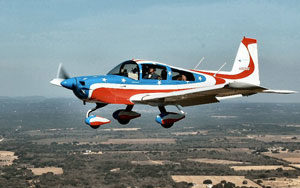 Many rural areas have transportation
services that can help patients access the healthcare
they need at the local level. But when specialty care
from a hospital or treatment center hundreds of miles
away is required, the barriers start to stack up. A long
road trip can be extremely uncomfortable for sick
patients, not to mention expensive.
Many rural areas have transportation
services that can help patients access the healthcare
they need at the local level. But when specialty care
from a hospital or treatment center hundreds of miles
away is required, the barriers start to stack up. A long
road trip can be extremely uncomfortable for sick
patients, not to mention expensive.
Rural Americans, who make up nearly 20% of the U.S. population, often have a greater distance to travel to reach a specialty care clinic, VA hospital, or cancer center than their urban counterparts. Unreliable transportation, weather, and finances are some of the reasons rural residents forego medical treatment from these locations, but doing so can have a significant impact on one's health, safety, and quality of life.
In the past several decades, dozens of independent, charitable flight services have cropped up to provide free flights for patients needing transportation to faraway treatment centers. Flown by pilots volunteering their time, fuel, and planes, these flights have reduced travel cost and the hassle of flying commercial for veterans, cancer patients, and even abused children. Though the target audience may vary, many charitable flight operations have a similar beginning: someone with a story, a pilot's license, and a big heart that wants to give back.
Honoring Veterans in the Air
Walt Fricke, founder of Veterans Airlift Command (VAC), also goes by "AirBoss" among his four employees, 2,600 volunteer pilots, and more than 16,000 veterans they've served. Based in Minnesota, VAC flies post-9/11 wounded warriors across the country for treatment.
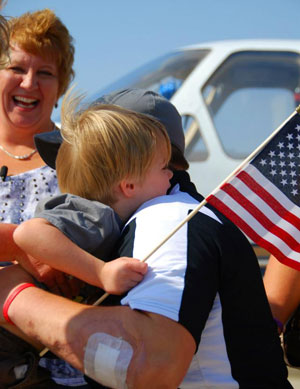
Fricke's personal experience as a wounded combat helicopter pilot in Vietnam inspired the founding of VAC. After his left foot was nearly amputated by a rocket misfire during an assault, he was sent to Fort Knox in Kentucky for surgery and recovery. His family lived in rural Traverse City, Michigan. "In those days, they had to gather the resources to make a trip like that," explained Fricke. "It was about six weeks before I saw my family, which was a significant deal for a 19-year-old kid."
Back in 1968, there were no charitable flight services like there are now. After Fricke retired from the nonprofit sector 12 years ago, he set out to solve this problem using his own plane to transport veterans and their families. "Turns out, it was the right idea at the right time, and we have had an outpouring of support from all over the country." Fricke formed a national network of volunteer pilots and has made flight coordination his full-time job.
"Many of our combat wounded return to their small communities of rural America, but still require ongoing specialized medical attention, which may only be available at larger regional VA facilities or military hospitals like Walter Reed [Army Medical Center]," said Fricke.
Planes flying for VAC and other charitable flight services can pick up passengers at the 4,590 public use airports and the 14,168 private use airports that aren't served by airlines, many of them located in rural areas. Fewer than 10% of public use airports in the U.S. are served by airlines, but their availability gives small, single-engine planes easy access.
Hear more about how Veterans Airlift Command benefits wounded veterans in this video:
A Win-Win for Patient and Pilot
Matt Young is a volunteer pilot for Angel Flight West (AFW). A semi-retired engineer, he grew up in rural Nebraska and now lives in rural Wyoming with his wife, Paula. Young understands the need for air transportation for sick patients who can't easily or quickly get to a large medical center. "Most of the passengers are getting specialized treatment that they can't get in their region," he said. "The cost of transportation to the specialized treatment facility might deplete their financial resources. I think that's probably a little unique to the rural areas: a 12-hour drive is a fairly significant venture for a lot of people. It might mean a difference in getting specialized treatment or not."
The cost of transportation to the specialized treatment facility might deplete their financial resources. I think that's probably a little unique to the rural areas: a 12-hour drive is a fairly significant venture for a lot of people. It might mean a difference in getting specialized treatment or not.
Like many who fly charitable missions, Young mainly uses his pilot's license for recreational and personal travel purposes. Because of a desire to make a difference with his hobby, he began serving with AFW in 2015. Young is one of 1,400 AFW pilots who have flown a total of 4,256 missions in the past year. These pilots volunteer their time and talent and cover 100% of the costs associated with the ownership and operation of their aircraft during an AFW flight.
Angel Flight West is one of seven Angel Flight organizations operating as independently run nonprofits. Based in California, AFW serves 13 western states, including Alaska and Hawaii. One-third of AFW passengers are youth and 80% have incomes below poverty level.
While some rural transportation programs offer reimbursement to volunteers, many charitable flight services do not. But Young says there are other reasons why so many pilots sign up for volunteer flight services, like keeping up proficiency with flying and trip coordination. "There is also certainly gratification that comes from it," said Young. "For most pilots, aviation is something that they enjoy. So if you can help somebody out at the same time, it's just a win-win situation for both the pilot and the passenger."
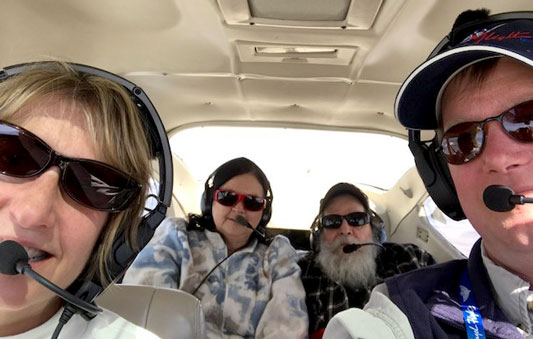
Compassion for the Sick among Us
The best part about being a volunteer pilot, according to Young, is the interaction with patients: "The encounters we've had with the passengers and some of the memories – the things that get said and done," he said. "We have had the opportunity of flying some people more than once. It's almost like catching up with old friends."
One memorable passenger is Edith, a toddler from a reservation in southeast Montana with a respiratory disorder that requires specialized care from the Children's Hospital Colorado. The Youngs have transported Edith for several surgeries.
Like many children, Edith spends most of her time in the air sleeping or playing with Paula in the backseat. The Youngs try to make the ride comfortable for patients and their companions by playing soothing music with blankets and pillows, snacks, and "sick sacks" available "just in case."
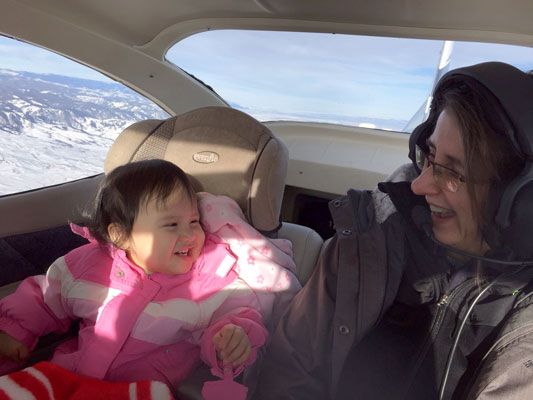
The Youngs also fly what AFW dubs "compassion flights," which aim to improve an ill person's quality of life, like flying a little girl to enjoy a week at a camp for kids with cancer. "Angel Flight will help with that and give these kids a chance to do something fun while they go through something really terrible," commented Young.
Although Young is in the cockpit instead of at a patient's bedside, he considers his service as a pilot a way to help improve a patient's situation: "It helps one interact in a compassionate way with the sick among us."
Similarly, Veterans Airlift Command not only transports wounded soldiers for medical treatment but also for mental health treatment. Hundreds of veterans have been flown to facilities like Shepard Center in Atlanta for traumatic brain injuries and post-traumatic stress disorder. VAC also flies veterans to service member funerals and unit reunions. They also transport family members to reunite with their soldiers in medical treatment for combat wounds. These experiences, Fricke said, can be the most healing.
Pilots get to 'write a thank you note' [to these veterans] with their airplane while being engaged in the process. It's more than just writing a check and sending it to some nonprofit…they actually get to experience the high feeling of helping somebody directly.
Like Fricke, many VAC pilots are veterans themselves. "It's such a visceral, hands-on experience. Pilots get to 'write a thank you note' [to these veterans] with their airplane while being engaged in the process. It's more than just writing a check and sending it to some nonprofit…they actually get to experience the high feeling of helping somebody directly."
Air Care Alliance
Angel Flight West and Veterans Airlift Command are part of the Air Care Alliance (ACA), an organization that helps coordinate charitable flight missions for healthcare and disaster relief. Volunteer pilots, patients, and hospitals can access more than 70 charitable flight organizations listed in their directory.
All ACA members operate independently but follow ACA policy and procedures. For example, ACA flights are limited to 600 nautical miles, which helps keep charitable flight organizations geographically-based and trips short. Members also refer pilots and services among one another.
Air Ambulance to the Rescue
Johnny Langland operates Footprints in the Sky, a charitable flight service for patients that uses corporate jets and charter planes. In the past five years, Footprints in the Sky has provided $10 million worth of free flights for patients. Footprints also provides air ambulance services, but for a cost. Receiving up to 1,000 air ambulance requests a year, Langland has recently been making a way for Footprints to provide free air ambulance flights for patients.
Air ambulances are helicopters, jets, or planes that can be equipped with medical supplies and have extra room for stretchers and medical professionals for patients in need of more medical assistance en route. While air ambulances help to quickly transport an acute care patient to a trauma center for emergency care, air ambulance trips are expensive, costing an average of $10,199 dollars. The more equipment used and miles traveled, the higher the cost. While insurance covers some of it, it's a steep price for the uninsured.
"In rural areas, there are a ton of people who don't have insurance, who don't have enough insurance. And when they need anything [medical] in addition to the airplane ride, it doesn't get done," explained Langland. "I have gotten calls from people who say they've put a mattress in the back of a pickup truck or motor home to solve this. In some cases, families raise money to pay for air ambulance."
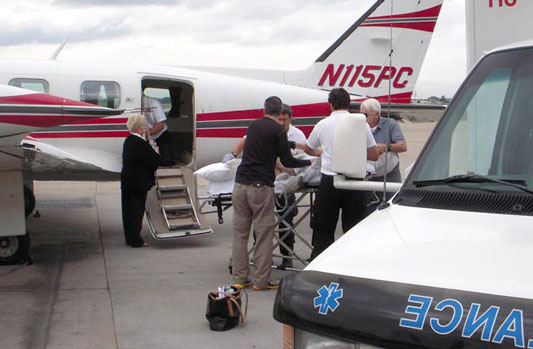
Langland has at least a dozen airplanes on standby for charitable air ambulance and is looking for funding options. Already, he has met with several cancer centers that have an interest and ability to offset the cost for transporting their patients living too far away to drive. He is also requesting hospitals to use their funding designated to treat uninsured patients. Rural medical centers in Hays, Kansas, and Glenwood Springs, Colorado, are interested in partnering to provide free flights to patients without insurance.
"So, we're close," Langland confirmed. "There is no shortage of air ambulance companies who get paid by insurance companies for their flights…what we are trying to do is take care of patients who truly don't have the money or the insurance."
Flights for Life
Although they don't transport patients, Flights for Life indirectly helps them by carrying donated blood to replenish hospital reserves. The charitable service coordinates pickups from blood banks and deliveries to rural and urban healthcare facilities in Arizona, New Mexico, Texas, and Oklahoma. Flights for Life began in 1984 and works with 200 volunteer pilots who are notified quickly when an emergency situation requires an immediate transfer.
"We service the outlying areas on an unscheduled basis and have the ability to alert all pilots of the need for transport," said Jerry Kapp, Flights for Life President. "We usually are able to get these products to the smaller areas of Arizona much more quickly than ground transport."
Giving Wings to Hurting Children
Karole Jensen formed Wings for Children in the 1970s as part of her child advocacy work in the family court system. Throughout her career in the courtroom, Jensen has helped set a national precedent for social workers' protection of children, drafting part of the South Carolina Child Protection Act and revising the Criminal Sexual Conduct Code that was passed into law in 1977 by the state legislature. It wasn't until getting her pilot's license that Jensen found an additional way to give wings to hurting children.
In 1993, she opened the flight branch of Wings for Children. It operates under the national Angel Flight organization but serves the Eastern States. Wings for Children now provides both legal advocacy and flight transportation services to children who have suffered abuse, neglect, and exploitation – all at no cost to the client or patient. "Nothing can describe the pure joy of helping these families," stated Jensen.
While they transport children year-round, Jensen pointed out there is an uptick in requests during summer months and holidays, when child abuse is reported more frequently. While a majority of the requests for charitable flight missions come from the patients themselves, referrals also flow in from hospitals, social workers, case managers, community agencies, and the court system. Because charitable flight organizations are independently run, rural hospitals aren't always aware of their existence.
They don't step that far out of the box until they recognize that they may not have the expertise and need to make a referral.
In her experience, Jensen has noticed that rural hospitals are generally more hesitant to take action when it comes to child abuse. "They don't step that far out of the box until they recognize that they may not have the expertise and need to make a referral," mentioned Jensen. That's where charitable flight operations like Wings for Children can have a valuable partnership with rural healthcare systems. "It may take more steps and more time, but when they do get a referral, that's when the patient starts getting the needed resources," explained Jensen.
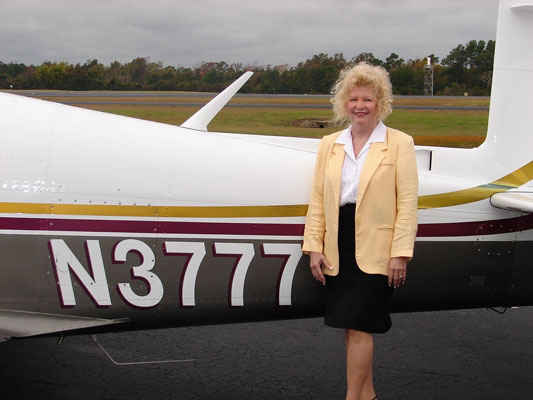
Additional RHIhub Resources
- Transportation to Support Rural Healthcare Topic Guide – Includes tips on how healthcare facilities can coordinate with transportation services for patient transfers.
- Rural Project Examples: Transportation – Features models and innovations that cover transportation services, including flight operations, that help rural patients access medical care.
- Rural Transportation Toolkit: Volunteer Models – Discusses volunteer models, including flight services, which can be implemented in rural areas.
